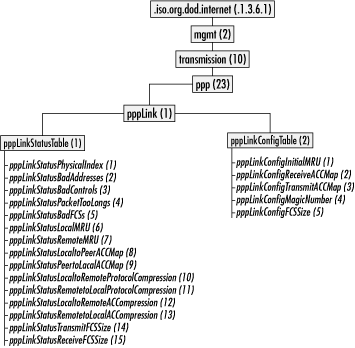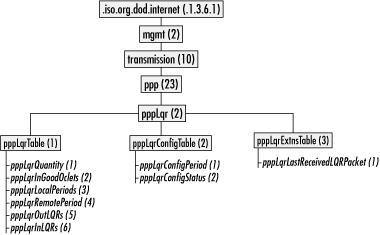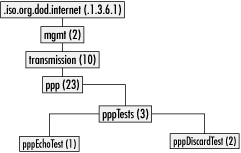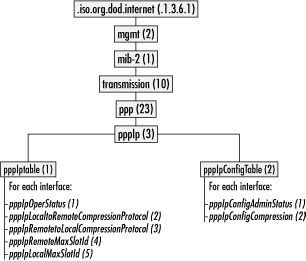To aid in the management of devices that terminate PPP sessions, several MIBs were defined to allow SNMP management stations to access PPP data. Four RFCs were published, each describing a subset of the PPP MIB. This appendix considers the two major RFCs, which provide the object definitions for the Link Control Protocol MIB and the IP Control Protocol MIB. In addition to the two major RFCs, there are bridging and security MIBs.
Taken together, the PPP MIBs define large groups. Broadly speaking, the major groups presented in this appendix are the Link Group, the LQR Group, LQR Extensions, and the IP Group. The first three are defined by RFC 1471, the LCP MIB. RFC 1473 defines the IPCP MIB.
RFC 1471 creates the PPP MIB in the
transmission group, putting it on par with both
the DS1 and frame relay DTE MIBs. In addition to defining the branch
off of the transmission group, it also defines
the Link Group, the LQR Group, the Tests Group, and the IP Group.
The Link Group reports information on LCP and the lowest layers of the PPP suite. It is composed of two tables: the link status table and the link configuration table. The Link Group is shown in Figure D-7.
The link status table is used to report
on the operational parameters of a link and its current status. All
entries in the table begin with the prefix
ppp.pppLink.pppLinkStatusTable.pppLinkStatusEntry
(23.1.1.1), and rows in the table are indexed by the main interface
index. All the entries in the table are read-only. They are:
-
pppLinkStatusBadAddresses(Counter) This counter reports the number of PPP frames received on the link with a bad address field in the HDLC header. Under most circumstances, the address field should be set to 0xFF. Any frames with incorrect address fields increase the general error count on the interface.
-
pppLinkStatusBadControls(Counter) This counter reports the number of PPP frames received on the link with a bad control field in the HDLC header. Under most circumstances, the control field should be set to 0x03. Any frames with incorrect control fields increase the general error count on the interface.
-
pppLinkStatusPacketTooLongs(Counter) This counter reports the number of frames that were discarded because they exceeded the MRU on the link. Some PPP implementations are flexible regarding the MRU, and implementations should always be able to receive frames of 1,500 bytes. This counter counts only the number of frames that are discarded for being too long; any frames that increment this counter will also increment the general error count on the interface.
The link configuration table monitors and
sets the values of configuration parameters for the link. All entries
in the table begin with the prefix
ppp.pppLink.pppLinkConfigTable.pppLinkConfigEntry
(23.1.2.1), and rows in the table are indexed by the main interface
index. All the entries in the table are writable so administrators
can configure the underlying parameters. When the network management
station changes a value, it goes into effect only when PPP is
reinitialized on the link. Here is a list of objects:
-
pppLinkConfigReceiveACCMap(string, length 4) This object is a 32-bit string that is equivalent to the asynchronous control character map required by the local end to decode any escaped characters in the incoming data stream. Its default value is all ones (0xFFFFFFFF). The remote node may also negotiate to escape additional characters, so the ACCM applied to the incoming data stream is derived from both this map and the transmit map on the remote end.
-
pppLinkConfigTransmitACCMap(string, length 4) This object is a 32-bit string that is equivalent to the asynchronous control character map required by the local end to send any special characters through its transmitter. Its default value is all ones (0xFFFFFFFF). The remote node may also negotiate to escape additional characters, so the ACCM applied to the outgoing data stream is derived from both this map and the transmit map on the remote end.
Implementation of the LQR Group is mandatory for all PPP implementations that also implement Link Quality Monitoring. Like the Link Group, it is split into a status table and a configuration table. The LQR Group is shown in Figure D-8.
The LQR table
provides access to operational parameters and statistics for the
local PPP implementation. All entries in the table begin with the
prefix ppp.pppLqr.pppLqrTable.pppLqrEntry
(23.2.1.1), and rows in the table are indexed by the main interface
index. All the entries in the table are read-only because they
provide access to statistics. Here is a list of the entries:
-
pppLqrQuality(enumerated integer) This object is set to
good(1),bad(2), ornot-determined(3). Link Quality Monitoring determines the quality of the link based on the number of link quality reports received. This object does not report on the policy used to determine link quality. Some implementations may measure quality but refrain from making a determination, which is why the third option may be used.
-
pppLqrOutLQRs(Counter) This object reports the value of the
OutLQRscounter. When LCP attempts to establish a link, the value of this counter is set to zero, and it is only reset when LCP terminates the link. While the link is active, this counter is incremented by one for each quality report transmitted by the local end.
-
pppLqrInLQRs(Counter) This object reports the value of the
InLQRscounter. When LCP attempts to establish a link, the value of this counter is set to zero, and it is only reset when LCP terminates the link. While the link is active, this counter is incremented by one for each quality report received by the local end.
The LQR
configuration table allows a network management station to alter the
configuration settings for Link Quality Monitoring. All entries in
the table begin with the prefix
ppp.pppLqr.pppLqrConfigTable.pppLqrConfigEntry
(23.2.2.1), and rows in the table are indexed by the main interface
index. All of the entries in the table are read-write to allow
administrative access. Changes to the objects in this table do not go
into effect until the PPP implementation is restarted. The entries
are:
-
pppLqrConfigStatus(enumerated integer) This object is either
enabled(1) ordisabled(2), depending on whether LQR negotiation should be attempted with the peer. The RFC does not specify exactly how an implementation should react to a management station setting a row todisabled; an agent may immediately remove the entry from the table, or it may keep the entry around while noting that it has been disabled.
This table is intended
to allow network management stations to use SNMP to assist in making
the policy determination of whether a link is good or bad. Only one
object is in the table, and it begins with the prefix
ppp.pppLqr.pppLqrExtnsTable.pppLqrExtnsEntry
(23.2.3.1). Rows in the table are indexed by the main interface
index. Here is a description of the object:
The Test Group allows network managers to write to objects and cause the PPP implementation to perform network troubleshooting tests. There are two objects in the group, each of which corresponds to a test; the Test Group is shown in Figure D-9.
The results of the test are reported
through the interface extensions MIB, specified in RFC 1229. The
particular object of interest is the
ifExtnsTestResult object, which is present in a
table of test results. ifExtnsTestResult can be
set to a number of values, but the two most important values are
success (2) and failed (7).
The fully qualified path to ifExtnsTestResult is
in the experimental branch, rather than the
mgmt branch, at
experimental.ifExtensions.ifExtnsTestTable.ifExtnsTestEntry
(3.6.2.1.5). Here are descriptions of the objects:
The IP Group enables network administrators to view the IP settings associated with each PPP link and configure IPCP-related parameters. The IP Group is defined in RFC 1473, and is shown in Figure D-10.
The IP table
is used to report the current IP configuration of each PPP link. All
entries in the table begin with the prefix
ppp.pppIp.pppIpTable.pppIpEntry (23.3.1.1), and
rows in the table are indexed by the main interface index. All the
entries in the table are read-only, and are listed here:
-
pppIpLocalToRemoteCompressionProtocol(enumerated integer) This object shows the IP compression protocol used by the local end when sending data to the remote end. Currently, only Van Jacobson compression is supported, so this object takes only the values of
none(1) andvj-tcp(2). This object is defined only when the IPCP state engine has reached the Open state.
-
pppIpRemoteToLocalCompressionProtocol(enumerated integer) This object shows the IP compression protocol used by the remote end when sending data to the local end. Currently, only Van Jacobson compression is supported, so this object takes only the values of
none(1) andvj-tcp(2). This object is defined only when the IPCP state engine has reached the Open state.
-
pppIpRemoteMaxSlotId(integer, range 0-255) Van Jacobson compression associates header information with slots. More slots can hold header information for a greater number of simultaneous connections, but they require more memory and more processing cycles on both ends. This object reports on the maximum number of slots advertised by the remote end. When Van Jacobson compression is not in use, this object takes the value of zero. Like the other compression-related objects, it is meaningful only when the IPCP state engine has reached the Open state.
-
pppIpLocalMaxSlotId(integer, range 0-255) This object reports on the maximum number of slots advertised by the local end. When Van Jacobson compression is not in use, this object takes the value zero. Like the other compression-related objects, it is meaningful only when the IPCP state engine has reached the Open state.
The IP configuration table allows a
network management station to alter the configuration settings for
the IPCP configuration. All entries in the table begin with the
prefix
ppp.pppIp.pppIpConfigTable.pppIpConfigEntry
(23.3.2.1), and rows in the table are indexed by the main interface
index. All the entries in the table are read-write to allow
administrative access. Here is a list of entries:
-
pppIpConfigAdminStatus(enumerated integer) Network administrators may use this object to change the administrative state of the IPCP state engine. Setting it to
open(1) will send an Open event to lower PPP layers, which will attempt to begin negotiation. Setting it toclosed(2) will send a Close event to lower layers, which will tear down the IPCP connection.
-
pppIpConfigCompression(enumerated integer) This object may be set to
none(1) orvj-tcp(2). When it is set tonone, IPCP will not attempt to negotiate any IP header compression. Any other value will cause IPCP to negotiate for that type of IP packet compression. Currently, only Van Jacobson header compression is defined. Changes to the objects in this table do not go into effect until the PPP implementation is restarted.




